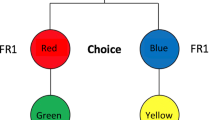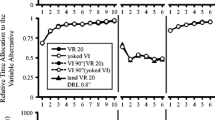Abstract
Pigeons alternated between simultaneously available, variable-interval 90-sec. schedules using a Findley changeover response procedure. Responses on the left key resulted in reinforcers according to the variable-interval schedules, while responses on the right key altered the reinforcement contingencies on the left key and initiated a changeover delay. Concurrent schedules were in effect when a changeover response alternated both the reinforcement schedule and discriminative stimulus on the left key. When the changeover response alternated only the reinforcement schedule, but not the discriminative stimulus on the left key, a parallel schedule was in effect. The lengths of the changeover delays were manipulated for both the concurrent and parallel schedules. For concurrent and parallel conditions, the birds were nondifferential between the components in terms of the relative proportion of responses emitted, time spent, and reinforcers received. When changeover delay was varied, changeover response rate was inversely related to the changeover duration. However, for a given changeover duration, changeover rate was consistently higher in concurrent than in parallel conditions. For both concurrent and parallel conditions, left-key response rate during the changeover delay was consistently greater than during post-changeover periods. A change in the discriminative stimulus (concurrent conditions) facilitates, but is not necessary for, the maintenance of changeover responding. These data suggest that the elevated rate on the left key during changeover delay is not affected greatly by variation in the discriminative stimuli, though the role of Pavlovian conditioning cannot be completely ruled out.
Similar content being viewed by others
References
BROWNSTEIN, A. J., & PLISKOFF, S. S. 1968. Some effects of relative reinforcement rate and changeover delay in response-independent concurrent schedules. Journal of the Experimental Analysis of Behavior, 11, 683–688.
BROWNSTEIN, A. J., & SHULL, R. I. 1970. Effects of changeover delay in concurrent schedules of reinforcement of keypecking by pigeons. Psychonomic Science, 19, 131–132.
CATANIA, A. C. 1966. Concurrent operants. W. K. Honig (Ed.), Operant behavior: Areas of research and application. New York: Appleton-Century-Crofts.
CATANIA, A. C., & REYNOLDS, G. S. 1968. A quantitative analysis of the responding maintained by interval schedules of reinforcement. Journal of the Experimental Analysis of Behavior, 11, 327–383.
FINDLEY, J. D. 1958. Preference and switching under concurrent scheduling. Journal of the Experimental Analysis of Behavior, 1, 123–144.
HEMMES, N. S. 1973. Behavioral contrast in pigeons depends upon the operant. Journal of Comparative and Physiological Psychology, 85, 171–178.
HERRNSTEIN, R. J., & LOVELAND, D. H. 1972. Food avoidance in hungry pigeons, and other perplexities. Journal of the Experimental Analysis of Behavior, 18, 369–383.
KELLER, K. 1974. The role of elicited responding in behavioral contrast. Journal of the Experimental Analysis of Behavior, 21, 249–257.
KILLEEN, P. 1972. A yoked-chamber chamber comparison of concurrent and multiple schedules. Journal of the Experimental Analysis of Behavior, 18, 13–22.
KISH, G. B. 1966. Sensory reinforcement. W. K. Honig (Ed.), Operant behavior: Areas of research and application. New York: Appleton-Century-Crofts.
MENLOVE, R. L. 1975. Local patterns of responding maintained by concurrent and multiple schedules. Journal of the Experimental Analysis of Behavior, 23, 309–337.
PLISKOFF, S. S. 1971. Effects of symmetrical and asymmetrical changeover delays on concurrent performances. Journal of the Experimental Analysis of Behavior, 16, 249–256.
RACHLIN, H. 1973. Contrast and matching. Psychological Review, 80, 217–234.
REDFORD, M., & PERKINS, C. C. 1974. The role of autopecking in behavioral contrast. Journal of the Experimental Analysis of Behavior, 21, 145–150.
SCHWARTZ, B. 1974. Behavioral contrast in the pigeon depends upon the location of the stimulus. Bulletin of the Psychonomic Society, 3, 365–368.
SCHWARTZ, B. 1975. Discriminative stimulus location as a determinant of positive and negative behavioral contrast in the pigeon. Journal of the Experimental Analysis of Behavior, 23, 167–176.
SCHWARTZ, B., & GAMZU, E. 1977. Pavlovian control of operant behavior. In W. K. Honig & J. E. R. Staddon (Eds.), Handbook of operant behavior. Englewood Cliffs, N.J.: Prentice-Hall.
SHULL, R. I., & PLISKOFF, S. S. 1967. Changeover delay and concurrent schedules: Some effects on relative performance measures. Journal of the Experimental Analysis of Behavior, 10, 517–527.
SHULL, R. I., & PLISKOFF, S. S. 1971. Changeover behavior under pairs of fixed-ratio and variable-ratio schedules of reinforcement. Journal of the Experimental Analysis of Behavior, 16, 75–79.
SILBERBERG, A., & FANTINO, E. 1970. Choice, rate of reinforcement, and the changeover delay. Journal of the Experimental A nalysis of Behavior, 13, 187–197.
WYCKOFF, L. B., Jr. 1952. The role of observing responses in discrimination learning. Part 1. Psychological Review, 59, 431–442.
Author information
Authors and Affiliations
Additional information
This research was supported by funds granted to James T. Miller by the Organized Research Fund of the University of Texas at Arlington. Portions of these data were presented at the meeting of the Midwestern Association for Behavior Analysis, Chicago, May 1975. Reprints may be obtained from Gordon Bourland, Division of Behavioral Psychology, John F. Kennedy Institute, 707 N. Broadway, Baltimore, Maryland 21205; or from James T. Miller, Department of Psychology, University of Texas at Arlington, Arlington, Texas 76019.
Rights and permissions
About this article
Cite this article
Bourland, G., Miller, J.T. Role of Discriminative Stimuli in Concurrent Performances: Duration of Changeover Delay. Psychol Rec 28, 263–271 (1978). https://doi.org/10.1007/BF03394535
Published:
Issue Date:
DOI: https://doi.org/10.1007/BF03394535




